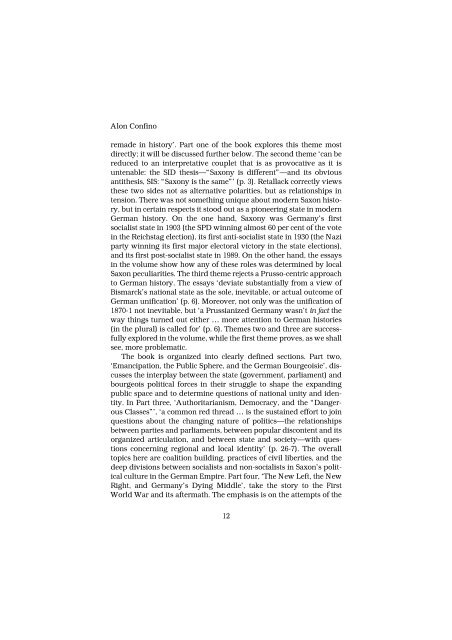Download - German Historical Institute London
Download - German Historical Institute London
Download - German Historical Institute London
You also want an ePaper? Increase the reach of your titles
YUMPU automatically turns print PDFs into web optimized ePapers that Google loves.
Alon Confino<br />
remade in history’. Part one of the book explores this theme most<br />
directly; it will be discussed further below. The second theme ‘can be<br />
reduced to an interpretative couplet that is as provocative as it is<br />
untenable: the SID thesis—“Saxony is different”—and its obvious<br />
antithesis, SIS: “Saxony is the same”’ (p. 3). Retallack correctly views<br />
these two sides not as alternative polarities, but as relationships in<br />
tension. There was not something unique about modern Saxon history,<br />
but in certain respects it stood out as a pioneering state in modern<br />
<strong>German</strong> history. On the one hand, Saxony was <strong>German</strong>y’s first<br />
socialist state in 1903 (the SPD winning almost 60 per cent of the vote<br />
in the Reichstag election), its first anti-socialist state in 1930 (the Nazi<br />
party winning its first major electoral victory in the state elections),<br />
and its first post-socialist state in 1989. On the other hand, the essays<br />
in the volume show how any of these roles was determined by local<br />
Saxon peculiarities. The third theme rejects a Prusso-centric approach<br />
to <strong>German</strong> history. The essays ‘deviate substantially from a view of<br />
Bismarck’s national state as the sole, inevitable, or actual outcome of<br />
<strong>German</strong> unification’ (p. 6). Moreover, not only was the unification of<br />
1870-1 not inevitable, but ‘a Prussianized <strong>German</strong>y wasn’t in fact the<br />
way things turned out either … more attention to <strong>German</strong> histories<br />
(in the plural) is called for’ (p. 6). Themes two and three are successfully<br />
explored in the volume, while the first theme proves, as we shall<br />
see, more problematic.<br />
The book is organized into clearly defined sections. Part two,<br />
‘Emancipation, the Public Sphere, and the <strong>German</strong> Bourgeoisie’, discusses<br />
the interplay between the state (government, parliament) and<br />
bourgeois political forces in their struggle to shape the expanding<br />
public space and to determine questions of national unity and identity.<br />
In Part three, ‘Authoritarianism, Democracy, and the “Dangerous<br />
Classes”’, ‘a common red thread … is the sustained effort to join<br />
questions about the changing nature of politics—the relationships<br />
between parties and parliaments, between popular discontent and its<br />
organized articulation, and between state and society—with questions<br />
concerning regional and local identity’ (p. 26-7). The overall<br />
topics here are coalition building, practices of civil liberties, and the<br />
deep divisions between socialists and non-socialists in Saxon’s political<br />
culture in the <strong>German</strong> Empire. Part four, ‘The New Left, the New<br />
Right, and <strong>German</strong>y’s Dying Middle’, take the story to the First<br />
World War and its aftermath. The emphasis is on the attempts of the<br />
12













